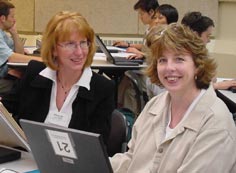 |
|
||||||||||||||||||||||||||

|
Although comprehensible input is key for second language acquisition, it is not sufficient. What we know is that learners must use language in meaningful interaction in order to learn it. At the onset of immersion programs in Canada in 1965, it was believed that all that was necessary for second language acquisition was to "immerse" learners in a language bath. Decades of research, however, have firmly established that this focus on comprehensible input in the immersion context has inhibited language growth in the learners (Genesee, 1987; Harley, 1984, 1992; Harley & Swain, 1984; Lyster, 1987; Spilka, 1976). It is now understood that teachers need to balance the provision of comprehensible input with opportunities for learners to produce "output," that is, to use language in meaningful ways to communicate meaning (Swain, 1985; among others). Stoller (2002) makes the case that in CBI classrooms, students need to be engaged in information gathering, processing, and reporting. These task-based activities or project work may best be enhanced by cooperative learning principles (Cummins, 2000; Stoller, 2002). See discussion about cooperative learning in Strategy 3: Integrating Modalities. Pair and group work is key for promoting interaction in the CBI classroom, yet students having lower proficiency levels will need scaffolds to be able to handle the linguistic demands of the task or they may revert to the use of their first language. To begin with, teachers need to prepare learners for the linguistic demands of the task by planning and implementing appropriate pre-task activities. In addition, a "language facilitator" may be assigned to work with a pair or assigned as a role in a cooperative group. The language facilitator checks for accuracy, assists with language, may report back to the class. This facilitator may benefit from using a monitor sheet that contains the suggested linguistic forms and possible answers (Fleak, 1992; in Shrum & Glisan, 2000). In the CBI classroom, output is also required for final performance assessment tasks, or "culminating synthesis activities," as Stoller (2002) calls them. Synthesizing information that originates from different sources (Stoller, 2002) is a cognitively and linguistically demanding task. To synthesize, students need to:
Such culminating synthesis activities or other final performance assessment tasks should be authentic whenever possible, that is, intended for real purposes and audiences (see Tedick, 2003). Creative uses of technology (web pages; video "texts"; PowerPoint presentations) can further enhance such tasks (Cummins, 2000).
References: Cummins, J. (1998). Immersion Education for the Millennium: What we have learned from 30 years of research on second language immersion. http://www.iteachilearn.com/cummins/immersion2000.html [also online at CoBaLTT website]. Fleak, K. (1992). Moving toward accuracy: Using the student monitor sheet with communicative activities. Foreign Language Annals, 25 , 173-178. Genesee , F. (1987). Learning through two languages: Studies of immersion and bilingual education. Cambridge, MA : Newbury House. Harley, B. (1984). How good is their French? Language and Society, 10, 55-60. Harley, B. (1992). Patterns of second language development in French immersion. Journal of French Language Studies, 2, 159-183. Harley, B. & Swain, M. (1984). The interlanguage of immersion students and its implications for second language teaching. IN A. Davies, C. Criper, & A. Howatt (Eds.). Interlanguage (pp. 291-311). Edinburgh: Edinburgh University . Lyster, R. (1987). Speaking immersion. Canadian Modern Language Review, 43 (4), 701-717. Shrum, J. L. & Glisan, E. W. (2000). Teacher's handbook: Contextualized language instruction (2 nd Ed.). Boston , MA : Heinle & Heinle. Spilka, I. (1976). Assessment of second language performance in immersion programs. Canadian Modern Language Review, 32 (5), 543-561. Stoller, F. (2002, March). Content-Based Instruction: A Shell for Language Teaching or a Framework for Strategic Language and Content Learning? Keynote presented at the annual meeting of Teachers of English to Speakers of Other Languages, Salt Lake City. [online at CoBaLTT website] Swain, M. (1985). Communicative competence: Some roles of comprehensible input and comprehensible output in its development. In S. Gass & C. Madden (Eds.), Input in second language acquisition (pp. 235-253). Rowley, MA : Newbury House. Tedick, D. (2003). CAPRII: Key concepts to support standards-based and content-based second language instruction. CoBaLTT Web Resource Center. [online]
|
||||||||||||||||||||||||||